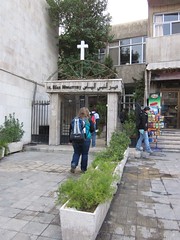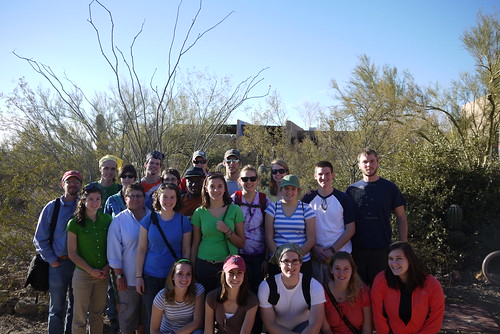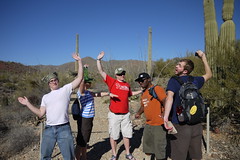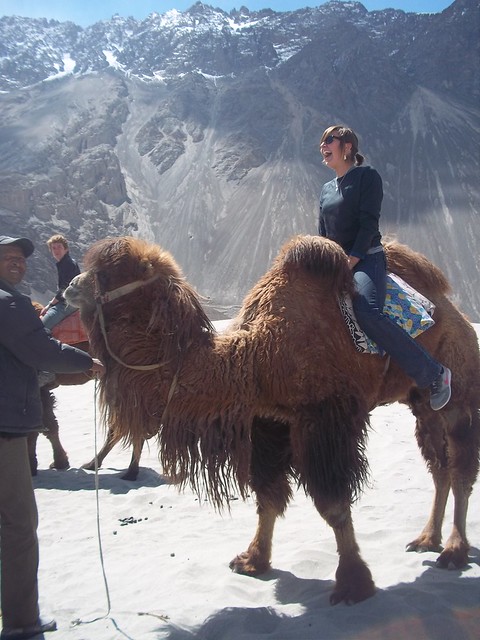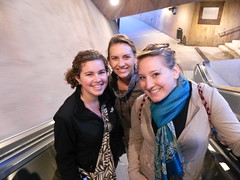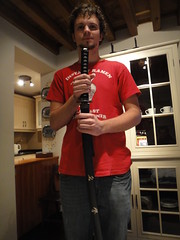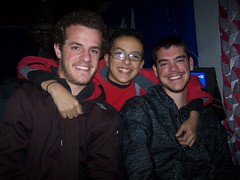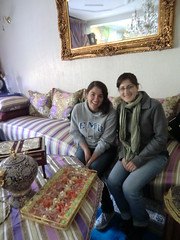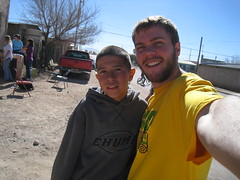 We are spending the weekend in Tuscon before we head to Guatemala for the bulk of our cross-cultural. This past week we were living in Agua Prieta, Mexico studying more about the border under the direction of Frontera de Cristo. Events to highlight are: walking immigrant trails in the Sonoran Desert, speaking first hand with deportees, touring a maquiladora and interacting with the U.S. Border Patrol. For this update I will share about our desert experience.
We are spending the weekend in Tuscon before we head to Guatemala for the bulk of our cross-cultural. This past week we were living in Agua Prieta, Mexico studying more about the border under the direction of Frontera de Cristo. Events to highlight are: walking immigrant trails in the Sonoran Desert, speaking first hand with deportees, touring a maquiladora and interacting with the U.S. Border Patrol. For this update I will share about our desert experience.
We’ve been learning a lot about immigration issues and laws, but this week we were able to see it in action. On Tuesday we visited Centro de Rehabilitacion y Recuperacion de Enfermos De Alcoholismo (C.R.R.E.D.A. or The Center for Rehabilitation and Recuperation from Drug and Alcohol Addictions). CRREDA works with recovering drug and alcohol addicts giving them a place to live while they recover from their addictions. One of the things they do is maintain multiple water stations in the desert for immigrants to refill their water bottles before they cross into the U.S. and make the trek through the Arizona part of the Sonoran Desert.
We went with them as they drove a truck out and topped off each of the 50 gallon drums. We ate lunch under a shade tree which kept the water nice and cool under its branches. As we got out our lunches, two heavily armed Mexican police seemingly popped out of nowhere. They were looking for drug dealers. The people we were with showed their credentials and we were left alone. After lunch in the cool shade, our local friends led us along trails that migrants walk. It was humbling to walk along trails that were possibly going to be traveled that very night by immigrants eager for a better life. As we reached the plain just before the fence our group spread out. I found myself weaving in and out, back and forth, trying to walk in open patches where the thorn bushes could not get at my legs. I had to think about the migrants traversing the same ground at night. They are not able to look around, scan the area ahead for the clearest path. They just have to follow their coyote (a guide) with no time to choose a safe route.
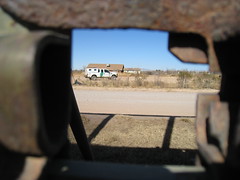 The first time I saw the wall I thought to myself “I wonder how hard it would actually be to climb it.” I got my chance out there in the desert; some of us climbed up the wall, I wanted to know how hard it would be. I got up without a terrible amount of difficulty, I just sat there, didn’t cross to the other side because that could be accompanied with criminal charges. After a while I heard shouts of “mira, la migra!!” (look, the border patrol). There as a quick scramble and everyone got down, it really wasn’t a big deal, the agent chatted with us for a bit and then drove away. I had to think about that for a bit. I was able to just climb that wall and not have much problem, but my Mexican friends weren’t able to just play around so freely.
The first time I saw the wall I thought to myself “I wonder how hard it would actually be to climb it.” I got my chance out there in the desert; some of us climbed up the wall, I wanted to know how hard it would be. I got up without a terrible amount of difficulty, I just sat there, didn’t cross to the other side because that could be accompanied with criminal charges. After a while I heard shouts of “mira, la migra!!” (look, the border patrol). There as a quick scramble and everyone got down, it really wasn’t a big deal, the agent chatted with us for a bit and then drove away. I had to think about that for a bit. I was able to just climb that wall and not have much problem, but my Mexican friends weren’t able to just play around so freely.
As we were heading back to the vans our friends pointed out, with some binoculars, a small group of migrants hiding out on the side of one of the mountains. It was this, walking the trails, and climbing the wall that brought the reality of migrants crossing the border into perspective for me. I had read about it but it always seemed so distant, like it was happening in a different time and place. Now it was happening right where I was and at the time that I was there.
So why do people cross illegally into the United States? We’ve studied this a lot, and it’s not because they want to take our jobs, be a bother, or in any way get in the way. They come because it’s their last resort. Their economy is struggling and there is little to be found to support a family in Mexico. When there are offers of cutting grass or working construction for ten dollars an hour, it’s hardly a question of whether or not to go. For many it is the only foreseeable way that they can support a family, so they make the life threatening trip to work here in the states and send the money back to their loved ones.
I work for a lawn care company during the summers and I work with immigrants, “amigos” as my employer calls them. They are “amigos,” and that’s it. Not given any high ranking jobs, and rarely allowed to drive the trucks or do the nicer jobs. I have also been influenced by our society and have made racial judgments due to lack of understanding. Through the desert experience and others this past week I feel like I am able to humanize the immigrants. I know, for the most part, why they are coming, how they come, and where their hearts are. From my observation the main driving factor in jumping the wall is love. Love for loved ones and family.
I will take this with me when I come back to the states, and with the Spanish that I pick up in Guatemala, I hope to connect on a personal level with immigrants.
-Austin Showalter

